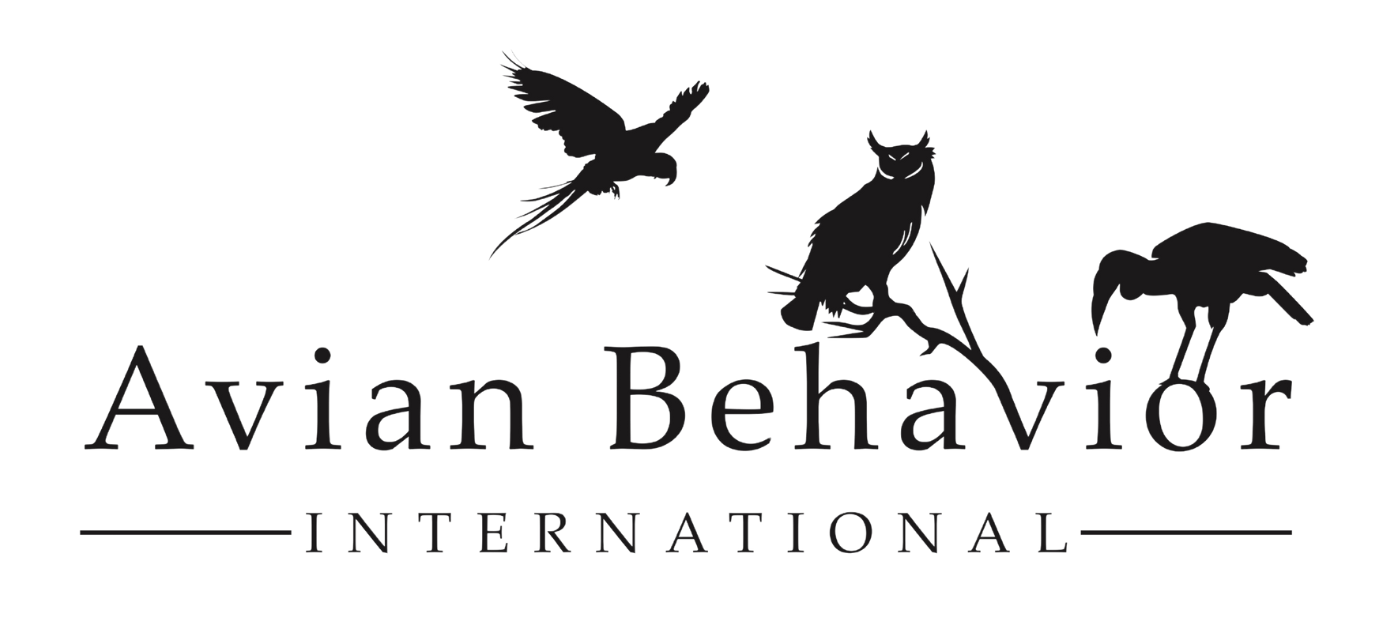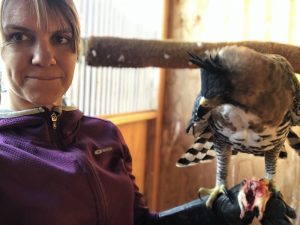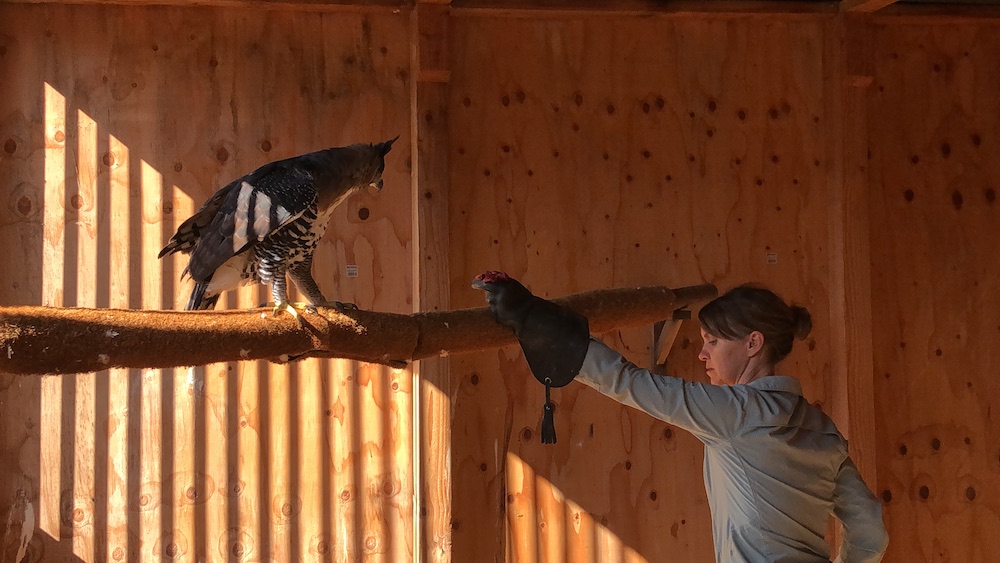
02 Oct Seven Tips to Building Trust with Birds of Prey
This past month, we had a webinar on how to build motivation in birds of prey and published our article that outlines our weight management philosophies (or lack thereof, as it is in some cases!). Often we think of training birds of prey as fairly simplistic because they aren’t social animals by nature, unlike parrots and some other birds. Our toolkit isn’t as large because they are so food motivated. A raptor’s food drive can create some problems, as they start to associate only some situations and interactions with food, and when they become satiated, they will choose to avoid us. This is not a new challenge, especially as falconry has been around for thousands of years.
This in and of itself is an over-simplified view of falconry and raptor training, whether you are an educator or a falconer. Building trust with a bird of prey isn’t just about becoming a food-delivery vessel, and there are steps that a trainer and falconer can take before we consider managing the bird’s weight. Differences in mechanics, timing and environment can literally shape our relationship with birds of prey from the ground up. Applying these will smooth the edges of what I often refer to as clunky training methods that rely on a handful of simple tools to build a stronger, more lasting relationship of much thicker fabric.
As mentioned in our other article regarding weight management, this is a step that takes thoughtful consideration and careful analysis of other factors.
At Avian Behavior International, we have a way of categorizing behaviors that impact how we respond: green, yellow and red. Green means the animal is comfortable with the way we are interacting together and we can continue forth. Yellow 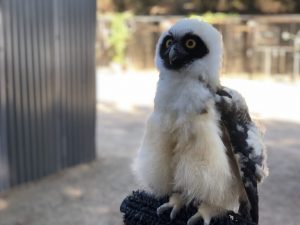 zone behaviors mean the animal is starting to show some avoidance behaviors, and we as trainers need to assess whether we can work through them or need to change our tack. Red zone behavior means the animal is in a state of fear, stress, frustration, avoidance and/or distress, and we have pushed him or her too far or something has happened that needs to be addressed immediately.
zone behaviors mean the animal is starting to show some avoidance behaviors, and we as trainers need to assess whether we can work through them or need to change our tack. Red zone behavior means the animal is in a state of fear, stress, frustration, avoidance and/or distress, and we have pushed him or her too far or something has happened that needs to be addressed immediately.
Some trainers and falconers purposefully push their bird of prey into the red zone so that the animal learns that there is nothing it can do to avoid or break free from this extreme state, and they have to get over it. In raptor training, methods such as manning and waking are used which are similar to other forms of animal training rooted in coercion. There is much scientific evidence to show that there are many fallout consequences to these techniques, some of which are more obvious than others. The following ideas focus on the more subtle ways of looking for techniques of staying in and expanding the green zone for a more robust relationship.
Set Up Your Bird of Prey’s Environment
Starting with your raptor’s home environment, this is one of the easiest ways to start with building a trusting relationship. There are many different mews and aviary designs for raptors, and not all are created equal for every facility. Some habitats might be great for a fully trained bird, but not great for a bird that still needs to learn how to get on the glove. What to do if you only have one mews for the bird you have?
Let’s take a look at what makes an environment successful for a bird of prey while we are trying to build trust. First, we want the bird to avoid rehearsing fear-based behavior patterns, especially when the stimuli are associated with humans. We might think that it is a good idea for the aviary to be in the middle of action that will help habituate the raptor to activity. However, in practice we can actually sensitize an animal to the presence of stimuli it finds aversive rather than desensitize it if it feels it has no way to find safety.
We had asked many friends and colleagues about training Eurasian Eagle Owls before we brought in our Guinness. One thing that was pointed out was that a centrally located aviary had really helped desensitize one center’s Eagle Owl to activity. So, we followed in suit. At the time, we had some landscaping help who was working on our irrigation lines and kept irregular hours, so we never knew when he was coming in. He would haul his wheelbarrow filled with PVC pipe past Guinness’s aviary. This was just too much for Guinness, even though he had been used to this kind of activity on a smaller scale before. We had to make some changes to fix the damage done that Guinness associated with this scenario.
Raptor mews will have solid walls and vertical bars so that they can’t grab mesh and crush their tails and primaries. With our newer birds, we use more heavily walled mews and those placed strategically so that they only see us when we are ready to work with them, which means we have something of value to offer them.
Often, birds of prey will be placed in mews that trainers walk by through the course of their day. If we aren’t paying attention, we could be sensitizing the raptors to our presence or creating stress and frustration in other ways.
If you aren’t sure about your bird’s set up, take some data. What does it look like throughout the day when you walk past, 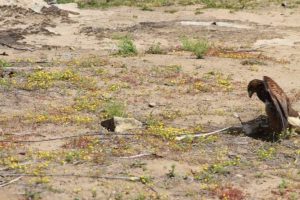 or can you hear it bouncing around? Bells on a bewit can also offer some data as to what the bird is doing when it isn’t visible. If your bird rarely has a time when it is sitting on a perch comfortably with a leg tucked, it’s important to understand why. If every time you pass, the bird feels it must get farther away, we might consider changing something about our visibility until we have developed a stronger relationship.
or can you hear it bouncing around? Bells on a bewit can also offer some data as to what the bird is doing when it isn’t visible. If your bird rarely has a time when it is sitting on a perch comfortably with a leg tucked, it’s important to understand why. If every time you pass, the bird feels it must get farther away, we might consider changing something about our visibility until we have developed a stronger relationship.
On the other hand, if the raptor rushes the bars when it sees us, this could be a strong indicator that he associates our presence with food and has unclear signals about the next time he will get fed. This can cause stress, which can lead to feather destructive behavior, aggressive patterns of behavior, and other forms of frustration. Feeding large or regular portions of food from obvious venues, program music, predictable or unpredictable routines can all create these types of patterns. When we feed out our birds of prey for the day that aren’t working, we use feeding tubes that conceal our approach. This way, they don’t associate our walking past the mews with getting food.
Some raptors need routine and others do better with a basic structure and a little fluidity inside that structure. Try to work with your bird if you have problems with one or the other.
Some raptors that have been in programs without a lot of variability will show anxiety-based behaviors when they hear the music that leads up to their particular role in an education program. If they are in a state of overexcitement, this can create problems for their handlers. While this may not be entirely a function of their environmental set up, it is worthy of note, regardless.
If you don’t have a lot of solid walls on your mews or aviary or have been feeding from an unconcealed approach and see a lot of intense behavior when trainers approach, consider modifying the environment. You can set up walls or plants to create a concealed approach for a feeding chute, or in some cases create a shift so that trainer and the bulk of food delivery are disassociated.
Make Sure Your Raptor Has Positive Associations With Your Presence
When we first start working with a bird of prey, we only want the bird to associate our presence with something it values. This means we set the environment up so that the bird can be safely left alone with comfort and clean water for the better part of the day. When it is time to eat, it is time to train.
This changes the way we look at a few things: how we clean the bird’s environment, where we keep the bird’s home, how we interact with the bird any time we are around it and handling it, and manning, or lack thereof (more on that below!). For falconers, it can mean down to the detail of a concealed approach off the trap. This can help educators and wildlife rehabilitators understand the enormous stress a bird of prey likely feels when it is transitioning to a new facility and to take extreme care when it first arrives so that new trainers are not associated with this transition. Trying to have a hands-off or concealed approach to the bird’s first moments can go a long way to helping the bird adjust and not pin its stress toward humans.
Whether you are working a new, untrained raptor free lofted or on a perch, one of the ways that we have found that actually builds trust faster is to leave the bird alone until it’s ready for its daily meal, and then I will approach it in a way that I can approximate my presence. I will either do so using the dark to light method, where the bird starts eating in controlled light so that the human form is obscured and once the bird is eating comfortably, gradually unmasked. Many falconers have used this method with wild birds to reduce stress, which in turn speeds up the process of early training and trust building. While speed is not the only factor to take into account as a measure of success, keeping a raptor’s stress low is an important part of these early steps.
If you have the right lofting set up, you can also use carefully placed shelving, perches and doors to allow the bird to gradually adjust to the human presence. Either method depends entirely many variables, including the bird in front of you, the trainer’s level of experience and sensitivity, and the amount of ambient activity you are able to control.
There is a time and place for allowing the bird to adjust to activity and human hustle and bustle. In the early days of training before a raptor is comfortable, subjecting to this type of stimuli will impede progress and can likely lead to 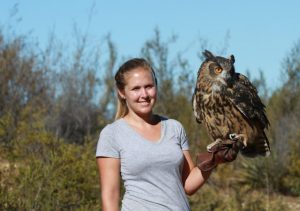 heavier weight management practices in the long run. Sticking a new falconry hawk on a perch in the middle of the living room, for instance, is not my preferred method of habituation. The level of stress the bird must endure before it has been prepared can impact later training choices.
heavier weight management practices in the long run. Sticking a new falconry hawk on a perch in the middle of the living room, for instance, is not my preferred method of habituation. The level of stress the bird must endure before it has been prepared can impact later training choices.
Keep early sessions short and impactful. Don’t exhaust a raptor’s attention span and concentration. He knows the difference between a good feeling crop and a light meal. If you make some good headway, make sure you end the session quickly with the bird having a relatively good amount of food for it.
What this also means is that we prepare for how we are going to tend to husbandry needs such as cleaning and changing water. Raking and shoveling can be terrifying to a new bird, and if you can’t handle the bird to move it a different location, shift or crate it, then finding a way of moving around the bird to create minimal yellow and red zone behaviors is of utmost importance to minimize stress.
Reconsider Manning in Raptor Training
Many bird of prey trainers use manning as a way of building a relationship with a raptor. Manning can take different forms, but generally means sitting with bird of prey on the glove for an extended period of time. Some trainers have been told they need to sit with birds for up to eight hours a day! This is a significant period of time, and typically manning comes without the delivery of food, and is just seen as an opportunity of relationship building as the bird gets used to the presence of the new person. If the bird bates off the glove, he is held on to until he stops bating. Protocols vary from organization to organization, but the ideas are generally the same.
This is not unlike the concept of sitting next to a new parrot’s cage and reading a book or talking quietly so that the bird gets used to their new home and people. It removes choices from the bird’s environment and important opportunities for inter-species communication. If the bird is ping-ponging around the cage, the idea is to wait it out and keep reading until the bird stops. Not unlike a bating raptor.
While we at ABI rarely find a need for the manning as a regular part of our training protocol, though always’ and nevers 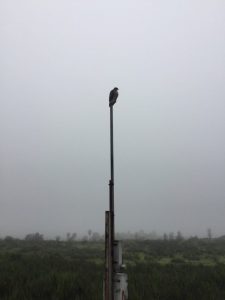 are not words we find useful. Manning is simply not a strategy we use as a regular part of our relationship-building training paradigm.
are not words we find useful. Manning is simply not a strategy we use as a regular part of our relationship-building training paradigm.
A bird of prey doesn’t have a favorite tree because it just sits there. It has a favorite tree for the opportunity it provides: hunting and foraging opportunities, the view and scouting prospects for interlopers and mates, and the vantage for thermals and drafts.
Therefore, at ABI, we build relationships with birds of prey through the delivery of reinforcers: food, training sessions, opportunity. Manning can be seen as a restrictive process the bird has no choice or voice in. It can actually be detrimental and thus, antithetical to how we want our birds to view us. Instead, we can work with our birds in a way that they are always ready to get on our glove, even if that means training them to sit for long intervals before the delivery of a reinforcer ever occurs.
Hold ‘Em Up!
When working with a new raptor, trying holding the bird of prey up higher than eye level and
see if that changes the bird’s body language or readiness to fly. When we first started working with Casino, our augur buzzard, we would notice that he would fly to our gloves faster when they were held higher than lower. While some 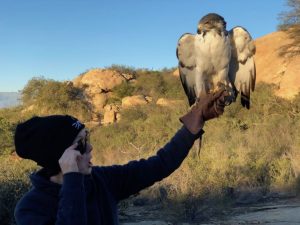 raptors -ahem, owls- may not appreciate the extra work of flying more vertically, it could make a huge difference in reducing latency. In working with newer falconry birds which are often more sensitive hawks, I have noticed a huge confidence boost in being held up high in the earlier days of their training, which translates to building trust faster. Eventually I can approximate a lower glove level.
raptors -ahem, owls- may not appreciate the extra work of flying more vertically, it could make a huge difference in reducing latency. In working with newer falconry birds which are often more sensitive hawks, I have noticed a huge confidence boost in being held up high in the earlier days of their training, which translates to building trust faster. Eventually I can approximate a lower glove level.
Lower Your Eyes
Lowering your eyes and keeping from a direct stare can make a positive impact on early training sessions with a bird of prey. There have been several early sessions with a falconry bird I have been working with that moved forward by leaps and bounds when I averted my eyes and kept my glove in my peripheral line of sight.
Just like glove height, using a tool like this can be gradually approximated into a more casual training relationship, but it’s a valuable nuance that can help build trust with a sensitive raptor.
Use a Variety of Food Items
Not all food items are created equal. Different species and individuals value prey items on a unique level. Quail, rabbit, hare, mouse, rat, pigeon, fish, beef heart, and day old chick are all prey items that may be used depending on the species that you are working with. Nutrition levels are different for each item, bone densities may not be appropriate for the bird of prey you are working with, and some items may need to vary in quantity and proportion depending on the weather. Much can be done by keeping valued items rare and lower value items for non-working or easy work days. Birds that previously would leave day old chick might start eating it when they only get rodent when they have to work for it.
The Metabolism Cycle
Birds of prey have a different metabolism cycle than ours, or herbivores and omnivores in general. In Nick Fox’s Understanding Birds of Prey, he has a neat write up on their metabolic cycle including several graphs and charts. While some birds of prey, such as smaller falcons and accipiters, should be fed multiple meals to avoid hypoglycemia and even death, larger birds can be fed one larger meal a day, or perhaps in some cases one large meal and a small bit or two spaced well apart.
When fed throughout the day, we see a lower interest in food, thus they get fed less and a lower quality of behavior and motivation. This can increase the risk of fly offs and aggressive incidents. As mentioned in our article about progressive views on weight management, we look for opportunities for feasting and fasting, which means a few bulk days with hefty 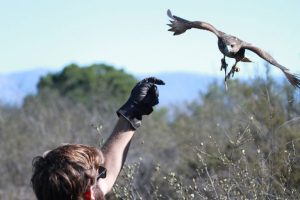 crops mixed in with lighter days of lower crops. This helps us establish a program in which our birds have a healthy relationship with food and aren’t looking to overstuff themselves given the opportunity.
crops mixed in with lighter days of lower crops. This helps us establish a program in which our birds have a healthy relationship with food and aren’t looking to overstuff themselves given the opportunity.
With birds of prey, food may be the currency that helps us achieve our goals, but nuance plays a huge role in the trust that is layered in to the relationship. Magnificent behaviors come from the tiniest of details, from the first moments of the transition to our lives to the way we ask them to step off our glove at the end of the day. Putting in the thought to these questions now helps us create patterns in our own behavior that become routine for each bird we work with from here on out.
Are you a member? Join the conversation in our community forum, where our incredible members are making great strides in their training programs! You can try out an annual premium membership for just 3 bucks! Use the coupon code TEN. We also have a comprehensive masterclass that goes into even more detail about raising the perfect ambassador owl (discounts for premium members!)
